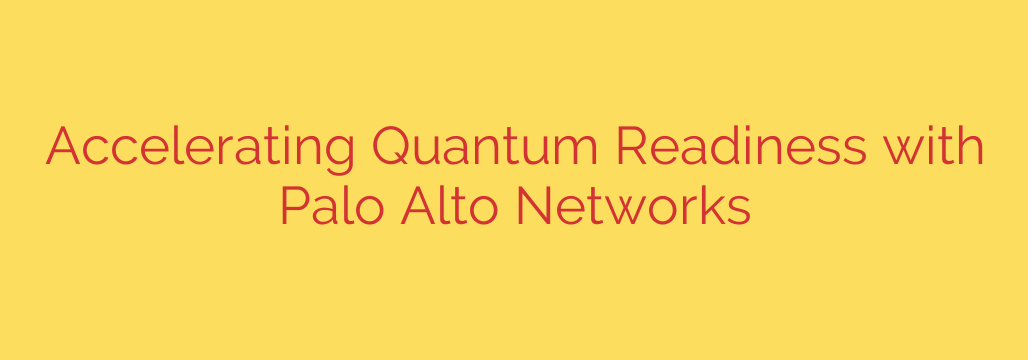
The Quantum Threat to Encryption: A Practical Guide to Post-Quantum Cryptography
The era of quantum computing is no longer a distant theoretical concept; it’s a rapidly approaching reality. While this technological leap promises incredible advancements in fields like medicine and materials science, it also poses one of the most significant threats to modern cybersecurity we have ever faced. At the heart of this threat is the vulnerability of our current encryption standards—the very foundation of digital trust.
For businesses, governments, and individuals, the time to prepare for a post-quantum world is now. Waiting until a powerful quantum computer is fully operational will be too late. Understanding the risk and taking proactive steps today is essential for securing our digital future.
The Coming “Cryptopocalypse”: How Quantum Computers Break Modern Encryption
Most of the world’s secure communications rely on public-key cryptography, using algorithms like RSA and Elliptic Curve Cryptography (ECC). These systems protect everything from online banking and e-commerce to secure messaging and government communications. Their security is based on the extreme difficulty for classical computers to solve specific mathematical problems, like factoring large numbers.
However, a sufficiently powerful quantum computer running Shor’s algorithm will be able to solve these problems with alarming speed, effectively shattering the security of RSA and ECC. This means that any data encrypted with these standards could be decrypted, exposing sensitive information that was once considered safe.
The most immediate danger is the “harvest now, decrypt later” attack. Malicious actors are already collecting and storing vast amounts of encrypted data today. They are betting that in the near future, they will have access to quantum technology capable of breaking the encryption and unlocking the secrets within. Data with a long shelf life—such as intellectual property, government secrets, financial records, and personal health information—is particularly at risk.
The Solution: Building a Quantum-Resistant Future with PQC
In response to this looming threat, the global cybersecurity community has been working to develop a new generation of encryption algorithms. Known as Post-Quantum Cryptography (PQC), these algorithms are designed to be secure against attacks from both classical and quantum computers.
PQC is not based on quantum physics itself; rather, it relies on different mathematical problems that are believed to be incredibly difficult for even quantum computers to solve. After a rigorous, multi-year competition, the U.S. National Institute of Standards and Technology (NIST) is in the final stages of standardizing a suite of PQC algorithms that will become the new benchmark for secure communication. The final standards are expected to be published in 2024, paving the way for widespread adoption.
The Challenge of Transition: Why Crypto-Agility is Crucial
Migrating from our current cryptographic standards to PQC is not as simple as flipping a switch. This transition will be a complex and time-consuming process, potentially taking years for large organizations to complete. The core challenge lies in a concept known as crypto-agility.
Crypto-agility is an organization’s ability to update or replace its cryptographic algorithms and protocols efficiently without causing major disruptions to its systems and infrastructure. Unfortunately, many existing systems were built with specific encryption methods hard-coded into them, making them difficult and expensive to upgrade.
Failing to build crypto-agility now will leave organizations exposed and scrambling to catch up when the quantum threat becomes immediate.
A 3-Step Roadmap to Quantum Readiness
Preparing for the post-quantum era requires a strategic and methodical approach. Instead of waiting for a crisis, organizations should begin their journey toward quantum resistance today. Here is a practical, three-step action plan to guide your efforts.
Step 1: Discover and Inventory Your Cryptographic Assets
You cannot protect what you cannot see. The first critical step is to conduct a thorough inventory of all cryptographic assets across your organization. This includes:
- Identifying where and how encryption is used.
- Locating all cryptographic keys and digital certificates.
- Understanding data dependencies and protocol usage.
Actionable Tip: Use automated discovery tools to map out your entire cryptographic landscape. This will provide the visibility needed to understand the full scope of your migration challenge.
Step 2: Prioritize and Develop a Migration Strategy
Not all systems carry the same level of risk. Once you have a complete inventory, you can prioritize your migration efforts based on the sensitivity and lifespan of the data being protected.
- Identify high-value assets and critical infrastructure that should be migrated first.
- Focus on systems that protect data requiring long-term confidentiality.
- Develop a phased transition plan that minimizes disruption.
Actionable Tip: Consider adopting a hybrid cryptographic approach. This involves using both a classical algorithm and a new PQC algorithm simultaneously to secure a connection. This provides a safety net, ensuring that communications remain secure even if one of the algorithms is compromised.
Step 3: Implement and Modernize Your Security
With a clear plan in place, you can begin the process of implementation. This involves working with technology vendors and upgrading your security infrastructure to support PQC.
- Engage with your vendors to understand their PQC roadmaps and ensure their products and services will be quantum-resistant.
- Start deploying PQC-capable technologies in new projects and pilot programs.
- Modernize your network security to support agile cryptographic transitions, for example, by upgrading VPNs to support PQC algorithms.
The transition to a quantum-resistant world is a marathon, not a sprint. The quantum threat to our current encryption standards is one of the most profound challenges in the history of cybersecurity. By understanding the risk, embracing crypto-agility, and following a strategic roadmap, organizations can turn this challenge into an opportunity to build a stronger, more resilient security posture for the future.
Source: https://www.helpnetsecurity.com/2025/08/14/palo-alto-networks-quantum-readiness/








